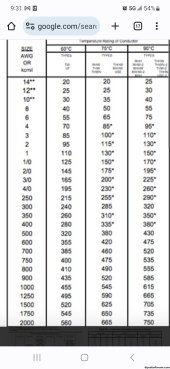kwest364
New Member
I have 4 x 12V 100Ah LiFePo4 batteries. Wired in series for 24V 200Ah. Batteries have 100A/1C discharge rate (LiTime brand).
So my breaker/shut off switch should be DC rated at 250A or 225A correct? 200 x 1.25 to allow for safety margin puts me around 250A, but 225A might be better due to lower threshold? I have 2/0 wire 105°C/220°F insulation, SGR wire from NAPA Auto. Ampacity charts seem to rate it up to around 325A. Call it 300A. (Pic attached)
Can I use a bolt on MRBF fuse? To simplify and make things cleaner? Forums seem to say for 24V systems, those are fine and safe to use.
Have 3000W inverter. Lynx distributor.
What size shut off switch to use? One that matches battery bank fuse I'm guessing? (225A or 250A) Or does this one not matter as much as long as I get a rated one for equal to or higher than 225/250A? I'm assuming I can bolt fuse straight into/on cut off switch. So battery bank to fuse, to cut off switch, all bolted together without needing to do wires and lugs.
Order of operations: battery bank(200A/24V) ---> 225/250A T or MRBF fuse --> cut off switch--> inverter (3000W/24V) --> lynx distributor. I got that order of operations right? All using 2/0 cable?
So my breaker/shut off switch should be DC rated at 250A or 225A correct? 200 x 1.25 to allow for safety margin puts me around 250A, but 225A might be better due to lower threshold? I have 2/0 wire 105°C/220°F insulation, SGR wire from NAPA Auto. Ampacity charts seem to rate it up to around 325A. Call it 300A. (Pic attached)
Can I use a bolt on MRBF fuse? To simplify and make things cleaner? Forums seem to say for 24V systems, those are fine and safe to use.
Have 3000W inverter. Lynx distributor.
What size shut off switch to use? One that matches battery bank fuse I'm guessing? (225A or 250A) Or does this one not matter as much as long as I get a rated one for equal to or higher than 225/250A? I'm assuming I can bolt fuse straight into/on cut off switch. So battery bank to fuse, to cut off switch, all bolted together without needing to do wires and lugs.
Order of operations: battery bank(200A/24V) ---> 225/250A T or MRBF fuse --> cut off switch--> inverter (3000W/24V) --> lynx distributor. I got that order of operations right? All using 2/0 cable?




